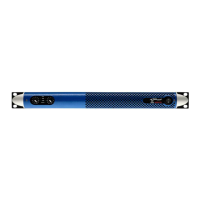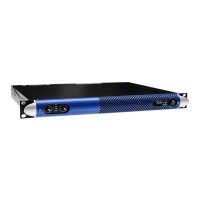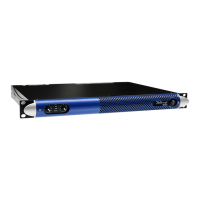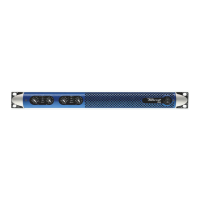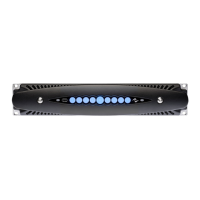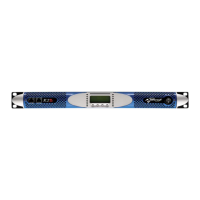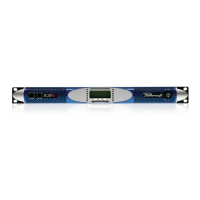▶
14
M Series User Guide
2 xover
Slope 6/12
dB/oct
Sl o pe 18/24
dB/oct
Slope 30/36
dB/oct
Slope 40/48
dB/oct
Free
biQuad
lters
remaining
10 8 6 4
▶
Peak limiter for every output
▶
RMS limiter for every output
▶
Frequency shaping
▶
Damping control for every output
5.12.4 Locking
The locking mechanism allows to lock macro property values
based on the functional sub section and on the channel base of
the device; the lockable sub sections are:
Input routing:
▶
Mono mix
Input Section:
▶
Equalizer
Output Section:
▶
Equalizer
▶
RMS Limiter
▶
Peak Limiter
▶
Damping Control
Every channel subsection is independently lockable.
5.12.5 On/Off
The on/off function is available when an external voltage is
supplied. Please refer to Section 5.11 on page 12 for further
information.
5.12.6 Preset Management
The DSP allows to manage up to 4 presets per module and its
associated channel pair. Each preset contains information on the
following:
▶
Input routing
▶
Input Section
▶
Output Section
▶
Properties locking
The preset is handled by the client as a le with the .preset
1 xover
Slope 6/12
dB/oct
Sl o pe 18/24
dB/oct
Slope 30/36
dB/oct
Slope 40/48
dB/oct
Free
biQuad
lters
remaining
11 10 9 8
extension, (see Section 6.4.1 on page 18) for further information.
These presets can be selected via a preset selection button on the
rear panel of the amp. There is one button for each DSP module.
The manual preset selection function is disabled if the amplier is
remotely controlled by any client.
Ampliers in the M Series are shipped with 4 default factory
presets: positions one and two store a 2 in /2 out routing preset
each with an input delay of 170 ms. Positions three and four store
a 1 in / 2 out preset with 340 ms input delay each.
WARNING: selecting a preset with a rear button or via remote
control will interrupt the audio stream for some seconds.
WARNING: store the modied preset before turning the unit off
or all changes will be lost. (Please refer to Section 6.5.7 on page 23
on how to access this feature).
NOTE: selecting presets with the rear button is enabled only if remote
control is NOT active.
6 Remote Control
The M Series allows full amplier remote control with Powersoft’s
software client Armonía. Other third party clients are also
available.
6.1 What Is Armonía?
Armonía is a software environment entirely developed in-house by
Powersoft. Its two main features are full end user remote control
of the amp and its signal processing capabilities. The intuitive
interface provides reliable information and real time control of all
DSP functions. Refer to the Armonía manual for installation and
conguration of the client software.
6.2 Connecting The Device
This chapter illustrates how to setup the remote control of one
or more ampliers.
6.2.1 Network
M Series ampliers come with one rear RJ45 port for remote
device communication, using the IP layer and the UDP protocol.
Factory default settings are DHCP/AutoIP, but a xed IP policy can
also be adopted.
6.2.1.1 DHCP
When the data cable is connected the amplier begins DHCP
handshaking. If a DHCP server is present on the network, the unit
is ready to be remotely controlled.
6.2.1.2 AUTOIP
Every device tries to set up network communication when the
data cable is plugged in and connected to another device (PC,
switch, etc.). If a DHCP server is not active in the device network
the units initiates a stateless address auto-conguration. It self

